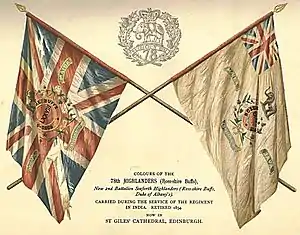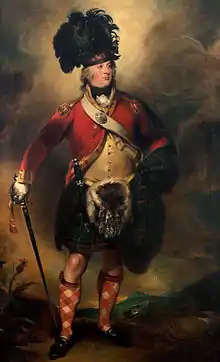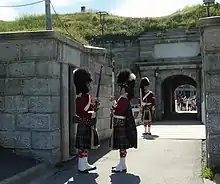78th (Highlanders) Regiment of Foot
The 78th (Highlanders) Regiment of Foot was a Highland Infantry Regiment of the Line, raised in 1793. Under the Childers Reforms it amalgamated with 72nd Regiment, Duke of Albany's Own Highlanders to form the Seaforth Highlanders in 1881.
| 78th Highland Regiment | |
|---|---|
 Colours of the regiment | |
| Active | 1793–1881 |
| Country | |
| Branch | |
| Type | Infantry Regiment |
| Role | Infantry |
| Garrison/HQ | Cameron Barracks, Inverness |
| Mascot(s) | Elephant |
| Engagements | French Revolutionary Wars Second Anglo-Maratha War Napoleonic Wars First Anglo-Afghan War Anglo-Persian War Indian Rebellion |
History
Early history

The regiment was raised by Francis Humberstone MacKenzie, Chief of the Clan Mackenzie, as the 78th (Highlanders) Regiment of Foot (or The Ross-shire Buffs) on 8 March 1793.[1] First assembled at Fort George in July 1793, the regiment embarked for Holland in September 1794 for service in the French Revolutionary Wars.[2] The regiment saw action at the defence of Nijmegen in November 1794.[2] In a bayonet attack there the regiment lost one officer and seven men; a further four officers and 60 men were wounded.[3] The regiment returned to England in April 1795 and then took part in the Battle of Quiberon Bay in June 1795 and the landing at Île d'Yeu in September 1795.[2]
The regiment also took part in the successful attack by a British fleet under Sir George Elphinstone on the Dutch Cape Colony, then held by the forces of the Batavian Republic: the attack led to the capitulation by the Dutch Navy at Saldanha Bay and the capture of the colony by British forces in summer 1796.[2][3] After returning home, the regiment embarked for India in February 1797 and saw action at the Battle of Assaye in September 1803 during the Second Anglo-Maratha War.[2] During the battle the regiment were tasked with retaking the Maratha gun line.[4]
A second battalion was raised in May 1804.[1] The 1st battalion remained in India and, from there, took part in the Invasion of Java and the capture of Fort Cornelis in August 1811.[2]
When the battalion was withdrawn from Java in September 1816 the vessel it was travelling on, Frances Charlotte, wrecked off Preparis on 5 November on the way to Bengal. There were relatively few deaths and Prince Blucher rescued most of the survivors, who it carried to Calcutta; cruisers from the British East India Company rescued the remainder. Prince Blucher carried a part of the battalion on to England.[5]
Napoleonic Wars
The 2nd battalion embarked for the Italy and took part in the Battle of Maida in July 1806[2] It also took part in the Alexandria Expedition in spring 1807.[6] Three companies of the regiment were captured at Al Hamed near Rosetta: among the prisoners was Thomas Keith who converted to Islam and entered Ottoman service.[7] The battalion then took part in the disastrous Walcheren Campaign in autumn 1809.[2] The battalion embarked for Holland in 1813 and took part in a skirmish at Merksem in January 1814.[2] The battalion returned home in 1815 and the two battalions amalgamated again in 1816.[2]
The Victorian era


The regiment embarked for a tour in Ceylon in April 1826 and did not return to England until February 1838.[2] It embarked for India again in April 1842 for service in the First Anglo-Afghan War.[2] While at Sindh, largely due to cholera, the regiment lost two officers, 496 soldiers and 171 women and children between September 1844 and March 1845.[8] It then moved to Persia in January 1857 and took part in the Battle of Khushab in February 1857 during the Anglo-Persian War.[2]

The regiment returned to India in May 1857 to help suppress the Indian Rebellion.[2] It took part in the recapture of Cawnpore in July 1857[9] and then took part in the reinforcement of Lucknow strongly defending the residency until it was relieved in November 1857.[2] The regiment won eight Victoria Crosses during the campaign[10][11][12][13][14][15] and its role at Lucknow was commemorated by poets such as John Greenleaf Whittier and Alfred, Lord Tennyson.[16] The regiment returned home in September 1859.[2]
.jpg.webp)
| Part of a series on the |
| Military history of Nova Scotia |
|---|
 |
|
The regiment embarked for Gibraltar in 1865 and then sailed on, in the troopship HMS Crocodile on 8 May 1869, to Halifax in Nova Scotia arriving on 14 May 1869.[2][17] Each summer, men from the regiment camped at Bedford to practice musketry at the military range.[18] On their departure in 1871, a farewell ball was hosted by the Grandmaster of the Masonic Lodge of Nova Scotia, Alexander Keith.[18] The regiment, together with 17 young local women who had married soldiers, embarked for Ireland in the troopship HMS Orontes in November 1871.[18]
As part of the Cardwell Reforms of the 1870s, where single-battalion regiments were linked together to share a single depot and recruiting district in the United Kingdom, the 78th was linked with the 71st (Highland) Regiment of Foot, and assigned to district no. 55 at Cameron Barracks in Inverness.[19] On 1 July 1881 the Childers Reforms came into effect and the regiment amalgamated with the 72nd Regiment, Duke of Albany's Own Highlanders to form the Seaforth Highlanders.[1]
Legacy

The regiment's legacy is retained through Nova Scotian institutions such as Citadel Hill, which features a living history program with animators portraying the 78th Highland Regiment and controls the 78th Highlanders (Halifax Citadel) Pipe Band, a grade one pipe band formed in 1983.[20]
Battle honours
Battle honours won by the regiment were:[1]
Victoria Cross recipients - Indian Rebellion of 1857
- Lieutenant Andrew Cathcart Bogle (29 July 1857)
- Lieutenant Joseph Petrus Hendrik Crowe (12 August 1857)
- Private James Hollowell (26 September 1857)
- Surgeon Joseph Jee (25 September 1857)
- Lieutenant Herbert Taylor MacPherson (25 September 1857)
- Assistant surgeon Valentine Munbee McMaster (25 September 1857)
- Colour Sergeant Stewart McPherson (26 September 1857)
- Private Henry Ward (25 September 1857)
Colonels of the Regiment
Colonels of the Regiment were:[1]
78th (Highlanders) Regiment of Foot (or The Ross-shire Buffs)
- 1793–1796: Lt-Gen. Francis Humbertson Mackenzie, Lord Seaforth
- 1796–1809: Lt-Gen. Alexander Mackenzie Fraser
- 1809–1812: Gen. Sir James Henry Craig, KB
- 1812–1822: Lt-Gen. Sir Samuel Auchmuty, GCB
- 1822–1834: Lt-Gen. Sir Edward Barnes, GCB
- 1834–1837: Lt-Gen. Sir Lionel Smith, Bt., GCB, GCH
- 1837–1851: Gen. Paul Anderson, CB, KC
- 1851–1853: Lt-Gen. Sir Neil Douglas, KCB, KCH
- 1853–1860: Lt-Gen. Sir William Chalmers, CB, KCH
- 1860–1863: Gen. Roderick Macneil
- 1863–1881: F.M. Sir Patrick Grant, GCB, GCMG
References
- "78th (Highlanders) Regiment of Foot (or The Ross-shire Buffs)". regiments.org. Archived from the original on 29 December 2006. Retrieved 31 July 2016.
- "78th (Highlanders) Regiment of Foot (or The Ross-shire Buffs): Locations". Regiments.org. Archived from the original on 23 February 2007. Retrieved 21 February 2017.
- "The 78th Highlanders or Ross-Shire Buffs: Part 1". Electric Scotland. Retrieved 20 February 2017.
- Millar, p. 73
- "The Loss of the Francis and Charlotte". Chronicles of the sea. 8 September 1838. Retrieved 9 December 2017.
- Pollock, p. 183
- Grant, James (1866). "Story of Thomas Keith." The Constable of France: And Other Military Historiettes. London: G. Routledge and Sons.
- "A melancholy monument to the ravages of disease in British India". The Victorian Web. Retrieved 21 February 2017.
- "Biography of Robert Brownlee 1833-1908". Brownlee.com.au. Retrieved 20 February 2017.
- "No. 22303". The London Gazette. 2 September 1859. p. 3302.
- "No. 22083". The London Gazette. 15 January 1858. p. 178.
- "No. 22154". The London Gazette. 18 June 1858. p. 2958.
- "No. 22445". The London Gazette. 8 November 1860. p. 4126.
- "No. 22154". The London Gazette. 18 June 1858. p. 2957.
- "No. 22248". The London Gazette. 12 April 1859. p. 1483.
- See John Greenleaf Whittier (The Pipes at Lucknow) and Alfred, Lord Tennyson (in The Defence of Lucknow, he refers to the 78th as "Havelock's glorious Highlanders").
- "The 78th Highlanders or Ross-Shire Buffs: Part 6". Electric Scotland. Retrieved 20 February 2017.
- "To Canada and Halifax". Halifax Citadel Regimental Association. Retrieved 21 February 2017.
- "Training Depots". Regiments.org. Archived from the original on 10 February 2006. Retrieved 16 October 2016.
- "78th Highlanders (Halifax Citadel)". 78th Halifax Pipe Band. Retrieved 25 December 2019.
Sources
- MacVeigh, James (1887). The Jubilee Memorial. The Historical Records of The 78th Highlanders Or Ross-shire Buffs, (Now 2nd Battalion Seaforth Highlanders) From 1793 to 1887. From Official and Authentic Sources. Dumfries.
- Millar, Simon (2006), Assaye 1803: Wellington's First and 'Bloodiest' Victory, Oxford: Osprey Publishing, ISBN 1-84603-001-3
- Pollock, Alsager (1837). The United Service Magazine, Notes of an Expedition to Alexandria of the year 1807. H. Colburn.
Further reading
- Fairrie, Lieutenant Colonel Angus (1998). Cuidich'n Righ: A History of the Queen's Own Highlanders (Seaforth and Camerons). Inverness: Regimental Headquarters, Queen's Own Highlanders.